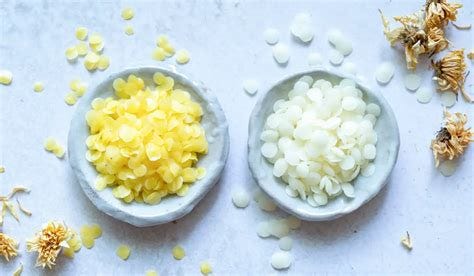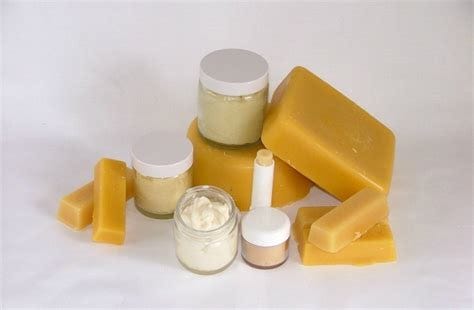Ingredient Spotlight - Beeswax
What beeswax is, where it comes from, and why it is good for us. (4 min read)
The History of Beeswax
Beeswax has beens used for centuries.
There are 8,000-year-old cave paintings depicting humans collecting honey from beehives. While the process of collecting honey has significantly improved nowadays, it is speculated that cavemen would have knocked down a beehive, run away, and then returned when the bees had calmed down or abandoned the hive. Beeswax was a valuable ingredient in the ancient world and had many uses.
The ancient Egyptians were one of the first civilizations to discover the value of beeswax.
They used it to preserve writings and paintings which are still intact today. They also realized the medicinal benefits of beeswax. There are prescriptions for the use of beeswax dating back to 1550 B.C. Beeswax was used for styling curls, making in face creams, creating candles, and to cast jewelry or figurines.
The Chinese, Greeks, and Romans all realized the benefits of beeswax and ingrained it into their culture.
How Beeswax is Made
Beeswax is made when a bee secretes wax from the eight glands on its abdomen.
A young bee will consume honey and then secrete it out in the form of wax. It will then chew up the wax and shape it into the octagonal shapes we associate with bees. As the bee grows older, its ability to do this diminishes, and the task is left to the younger bees. At peak production, a worker bee can produce 8 scales of wax in a 12-hour period. It takes 1,000 scales to make a gram of wax.
The Science
Beeswax is mainly composed of esters of fatty acids (fatty acids combined with alcohol). Let’s break this down.
The fatty acids - It is common to find the same fatty acids in beeswax as are typically found in tallow and jojoba oil. They are steric acid, palmitic acid, and oleic acid. (You can check out my blog post that talks more out this here).
Alcohols - A small percentage of beeswax is natural alcohols. These give beeswax its antimicrobial (fights against bacteria) and emulsifying (ability to smooth) properties.
Esters - Esters are produced when the acids and alcohol react. They add to the smooth texture and pleasant aroma of beeswax.
Different Types of Beeswax
Not all beeswax is the same.
Beeswax will differ, depending on what nectar the bees are collecting, the health of the hive, the surrounding geography, etc. There is one particular stark difference that should be noted.
White Beeswax versus Yellow Beeswax
Yellow beeswax - Yellow beeswax comes straight from the hive. Bees create it themselves and humans merely harvest it. Yellow beeswax has a natural aroma similar to honey and some from of yellow coloring (the color of beeswax can range from light yellow to almost red).
White beeswax - White beeswax is yellow beeswax that has been bleached. Due to this processing, its health benefits are diminished. White beeswax has little scent and is a light ivory color.
The long and short of yellow versus white beeswax is that yellow will have more health benefits and is more natural, but they both have many uses and are valuable in their own unique ways.
Health benefits
Beeswax holds little nutritional value, but can benefit our bodies in other ways.
Vitamin A - Vitamin A can promote collagen production which can lead to plump, youthful looking skin. Vitamin A is also beneficial to those with acne.
Emollient - Beeswax is an emollient which can smooth and soften skin.
Non comedogenic - Beeswax is non comedogenic, making it ideal for those who have acne prone skin.
Relieves pain - Beeswax has anti-inflammatory properties. It has been shown to help reduce swelling and joint pain.
And many more!
Popular Uses
Beeswax is one of God’s most versatile creations. It can be used in cosmetics, sculpting, candle making, and more. Let’s go through a few.
Lip Balm
Beeswax lip balm is an all time classic.
It doesn’t get much better than this. Beeswax offers many healing and sealing properties. While many modern chapsticks will increase the chapping on your lips, beeswax lip balm will protect your lips from the elements and moisturize your lips.
Not only will beeswax lip balm protect your lips, but it will also initiate deep healing.
Candle Making
In times past, beeswax candles were the candles of the wealthy.
Fortunately, in modern times, beeswax candles are widely available. While modern candles often contain paraffin, which can be harmful to humans, beeswax improves our health. Beeswax candles clean our air and add negative ions. Do you like the smell after a fresh rainfall? It is because of the negative ions. Similar to rainfall, snowfall, etc., beeswax candles will clean the air.
They are an excellent choice of candle, because they will to improve your health while letting you enjoy the relaxing light.
Wound Salve
Beeswax is effective for healing minor, cuts, scrapes, and wounds.
Due to its medicinal properties, beeswax is ideal for wound healing. It is known for its sealant properties, so it is perfect for protecting wounds from the elements. Beeswax will also keep inflammation and infection at bay due to its antimicrobial properties.
In Conclusion
Beeswax is a valuable and versatile commodity.
In the ancient world, it was praised for its versatility. There are a few different types of chapstick that each have their own unique attributes. Things like chapstick, candles, and wound salves can all be improved by adding beeswax. Beeswax can be beneficial to humans either by being applied topically, by purifying our air, or by helping us create art.
Thank you for reading!
Arete Tallow






